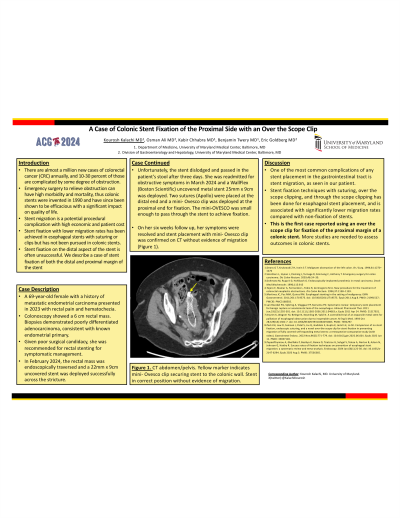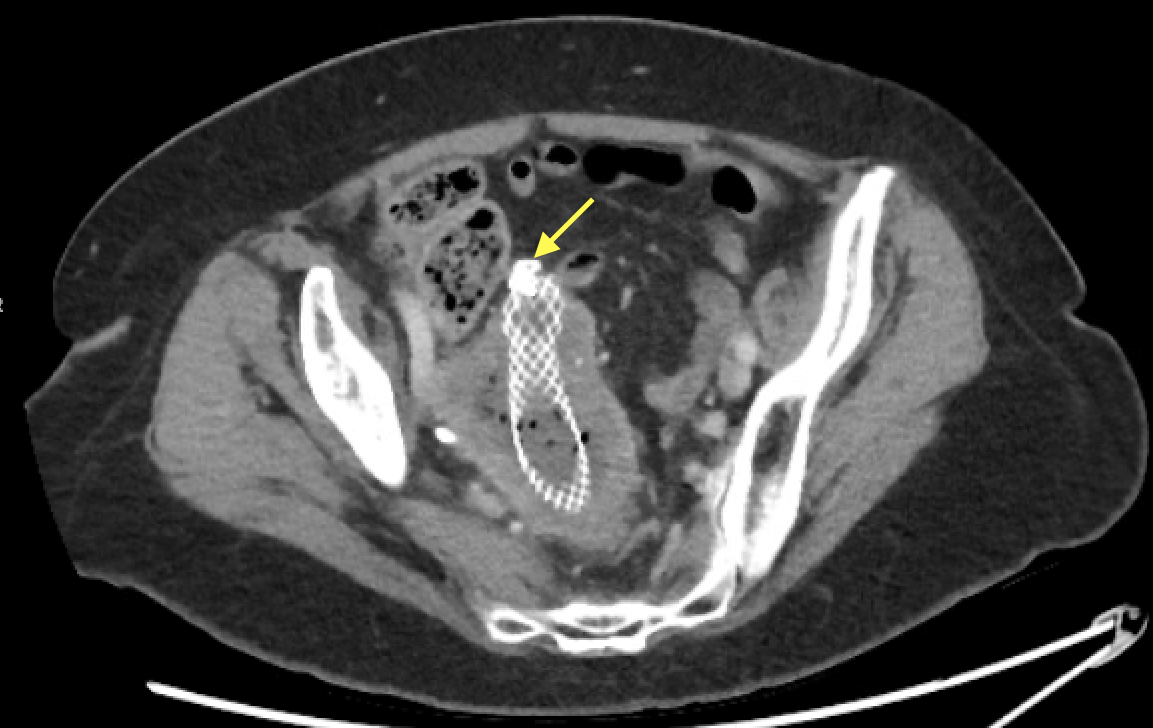Monday Poster Session
Category: Colon
P2032 - A Case of Colonic Stent Fixation With an Over the Scope Clip
Monday, October 28, 2024
10:30 AM - 4:00 PM ET
Location: Exhibit Hall E

Has Audio
- KK
Kourosh Kalachi, MD
University of Maryland Medical Center
Rockville, MD
Presenting Author(s)
Kourosh Kalachi, MD1, Osman Ali, MD2, Benjamin Twery, MD3, Kabir S. Chhabra, MD2, Eric Goldberg, MD4
1University of Maryland Medical Center, Rockville, MD; 2University of Maryland Medical Center, Baltimore, MD; 3University of Maryland School of Medicine, Baltimore, MD; 4University of Maryland School of Medicine, Fulton, MD
Introduction: There are almost a million new cases of colorectal cancer (CRC) annually, and 10-30% of those are complicated by some degree of obstruction. Emergency surgery to relieve obstruction can have high morbidity and mortality, thus colonic stents were invented in 1990 and have since been shown to be efficacious with a significant impact on quality of life. As with all gastrointestinal stents, migration is a potential procedural complication with high economic and patient cost requiring repeat procedures. Stent fixation with lower migration rates has been achieved in esophageal stents utilizing endoscopic suturing or clips but has not been pursued in colonic stents. This is likely because these fixation devices are too large to pass through the stent. Below we describe a case of colonic stent fixation with over-the-scope clips.
Case Description/Methods: A 69-year-old female with a history of metastatic endometrial carcinoma presented in 2023 with rectal pain and hematochezia. Colonoscopy showed a 6 cm rectal mass. Biopsies demonstrated poorly differentiated adenocarcinoma, consistent with known endometrial primary. Given poor surgical candidacy, she was recommended for rectal stenting for symptomatic management. In February 2024, the rectal mass was endoscopically traversed and a 22mm x 9cm uncovered stent was deployed successfully across the stricture. Unfortunately, the stent dislodged and passed in the patient’s stool after three days. She was readmitted for obstructive symptoms in March 2024 and a WallFlex (Boston Scientific) uncovered metal stent 25mm x 9cm was deployed. Two sutures (Apollo) were placed at the distal end and a mini-Ovesco clip was deployed at the proximal end for fixation. The mini-OVESCO was small enough to pass through the stent to achieve fixation. On her six weeks follow up, her symptoms were resolved and stent placement was confirmed on CT without evidence of migration (Figure 1).
Discussion: A common complication of any stent placement in the gastrointestinal tract is stent migration, as seen in our patient. Stent fixation techniques with suturing, over the scope clipping, and through the scope clipping has been done for esophageal stent placement, and is associated with significantly lower migration rates compared with non-fixation of stents. To our knowledge, this case is the first reported use of over the scope clips, with or without endoscopic suturing, for the successful fixation of a colonic stent. More studies are needed to assess outcomes in colonic stents.

Disclosures:
Kourosh Kalachi, MD1, Osman Ali, MD2, Benjamin Twery, MD3, Kabir S. Chhabra, MD2, Eric Goldberg, MD4. P2032 - A Case of Colonic Stent Fixation With an Over the Scope Clip, ACG 2024 Annual Scientific Meeting Abstracts. Philadelphia, PA: American College of Gastroenterology.
1University of Maryland Medical Center, Rockville, MD; 2University of Maryland Medical Center, Baltimore, MD; 3University of Maryland School of Medicine, Baltimore, MD; 4University of Maryland School of Medicine, Fulton, MD
Introduction: There are almost a million new cases of colorectal cancer (CRC) annually, and 10-30% of those are complicated by some degree of obstruction. Emergency surgery to relieve obstruction can have high morbidity and mortality, thus colonic stents were invented in 1990 and have since been shown to be efficacious with a significant impact on quality of life. As with all gastrointestinal stents, migration is a potential procedural complication with high economic and patient cost requiring repeat procedures. Stent fixation with lower migration rates has been achieved in esophageal stents utilizing endoscopic suturing or clips but has not been pursued in colonic stents. This is likely because these fixation devices are too large to pass through the stent. Below we describe a case of colonic stent fixation with over-the-scope clips.
Case Description/Methods: A 69-year-old female with a history of metastatic endometrial carcinoma presented in 2023 with rectal pain and hematochezia. Colonoscopy showed a 6 cm rectal mass. Biopsies demonstrated poorly differentiated adenocarcinoma, consistent with known endometrial primary. Given poor surgical candidacy, she was recommended for rectal stenting for symptomatic management. In February 2024, the rectal mass was endoscopically traversed and a 22mm x 9cm uncovered stent was deployed successfully across the stricture. Unfortunately, the stent dislodged and passed in the patient’s stool after three days. She was readmitted for obstructive symptoms in March 2024 and a WallFlex (Boston Scientific) uncovered metal stent 25mm x 9cm was deployed. Two sutures (Apollo) were placed at the distal end and a mini-Ovesco clip was deployed at the proximal end for fixation. The mini-OVESCO was small enough to pass through the stent to achieve fixation. On her six weeks follow up, her symptoms were resolved and stent placement was confirmed on CT without evidence of migration (Figure 1).
Discussion: A common complication of any stent placement in the gastrointestinal tract is stent migration, as seen in our patient. Stent fixation techniques with suturing, over the scope clipping, and through the scope clipping has been done for esophageal stent placement, and is associated with significantly lower migration rates compared with non-fixation of stents. To our knowledge, this case is the first reported use of over the scope clips, with or without endoscopic suturing, for the successful fixation of a colonic stent. More studies are needed to assess outcomes in colonic stents.

Figure: Figure 1. CT abdomen/pelvis. Yellow marker indicates mini-Ovesco clip securing stent to the colonic wall. Stent in correct position without evidence of migration.
Disclosures:
Kourosh Kalachi indicated no relevant financial relationships.
Osman Ali indicated no relevant financial relationships.
Benjamin Twery indicated no relevant financial relationships.
Kabir Chhabra indicated no relevant financial relationships.
Eric Goldberg: Boston Scientific – Consultant.
Kourosh Kalachi, MD1, Osman Ali, MD2, Benjamin Twery, MD3, Kabir S. Chhabra, MD2, Eric Goldberg, MD4. P2032 - A Case of Colonic Stent Fixation With an Over the Scope Clip, ACG 2024 Annual Scientific Meeting Abstracts. Philadelphia, PA: American College of Gastroenterology.
